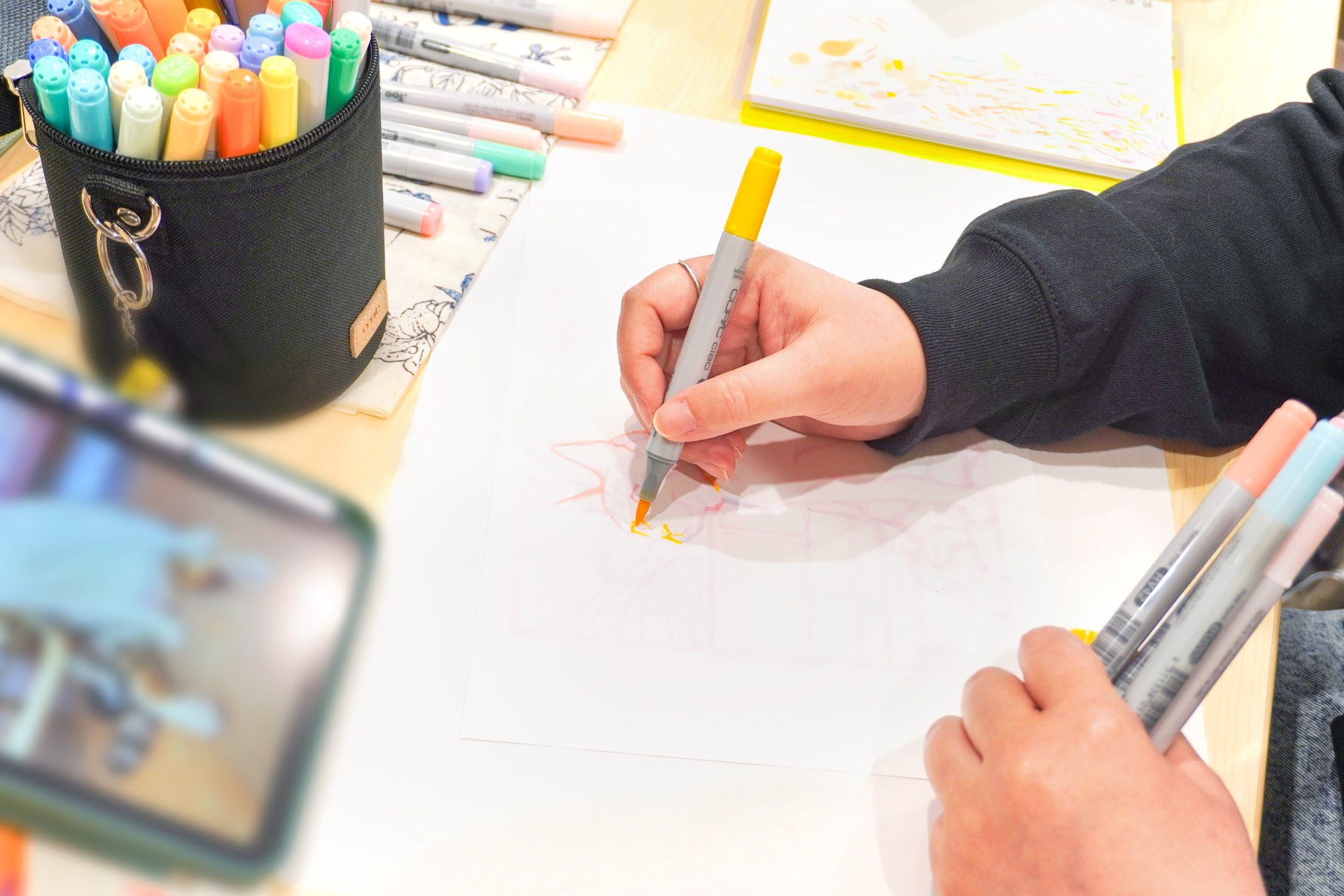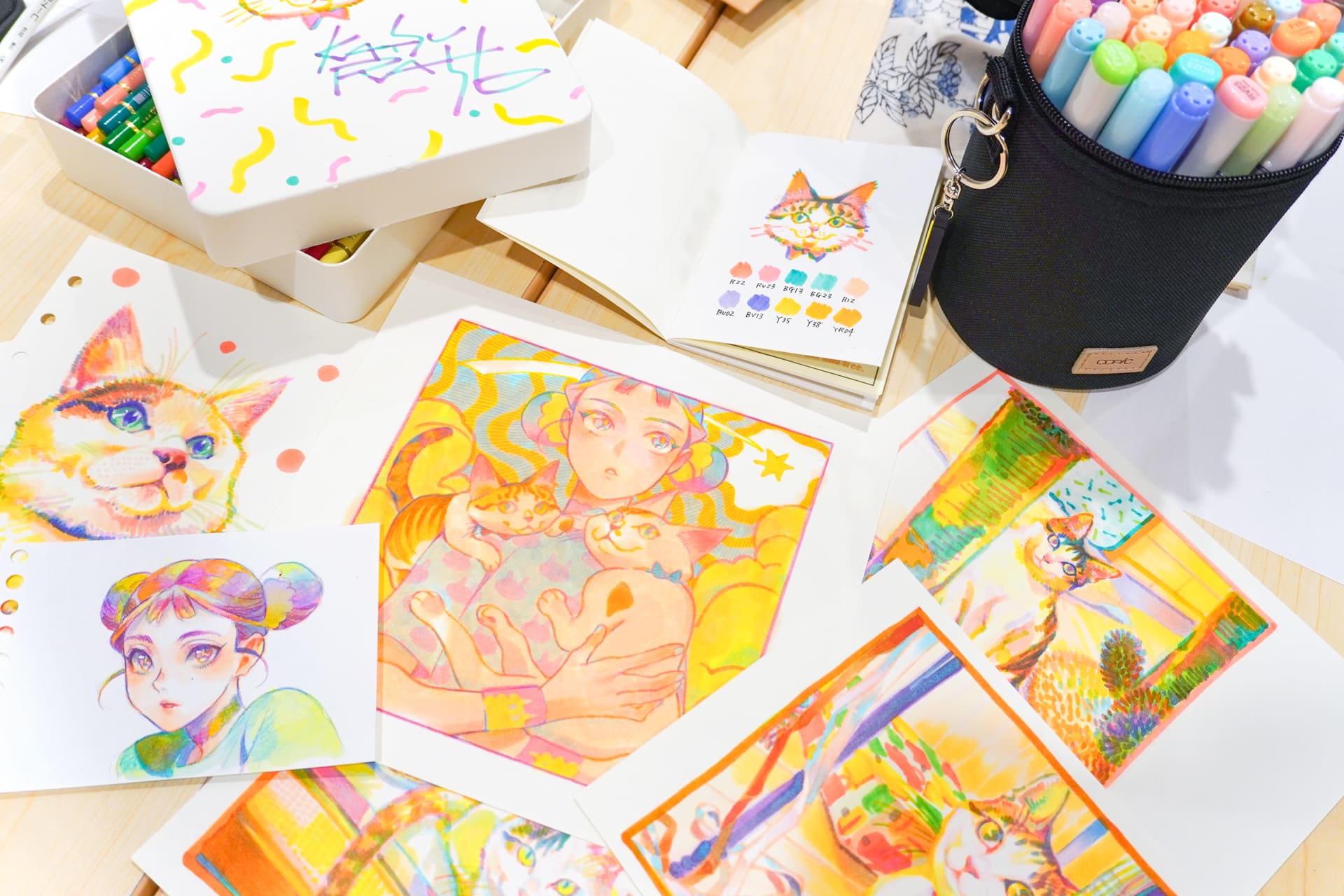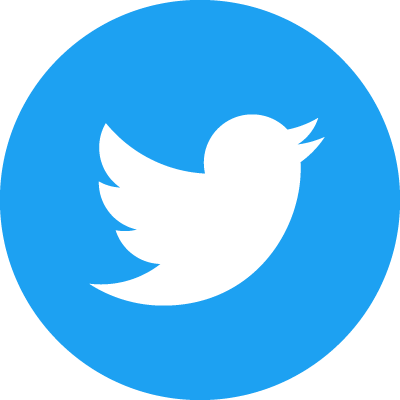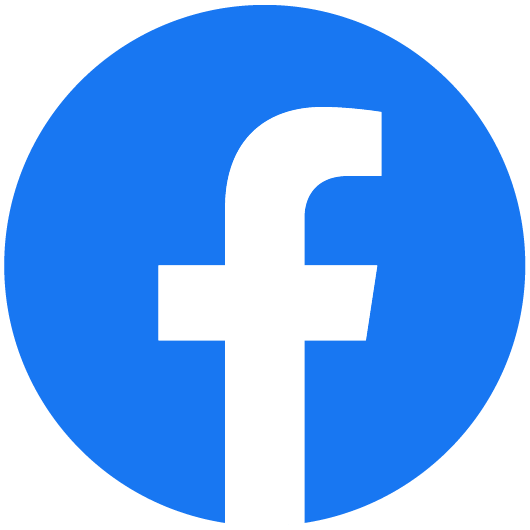- Category:
- All
- Design
- Illustration
- Manga
- Craft

Katsura Hoshino was born in 1980 in Shiga Prefecture, Japan. After working as an animator, she made her debut in 2002 with the publication of ZONE in Shueisha's manga magazine. In 2004, Shueisha began publishing Hoshino's D. Gray-man in Weekly Shonen Jump, which led to anime adaptations in 2006 and 2016 and two games released in 2007 and 2008. The manga has gained immense popularity, with 28 volumes published and over 24 million copies in total. Currently, D. Gray-man is being serialized in Jump SQ. RISE.
Instagram: @katsura_5600
Hoshino sensei, the acclaimed manga artist who served as a judge for the 2023 COPIC AWARD, has the complete 358-color Copic markers lineup and other Copic products in her home and now uses them primarily for her creative hobbies.
In this special feature, we had the privilege of interviewing Hoshino Sensei, who generously provided us with an original illustration of her beloved cat, Choro-chan.
Read Hoshino sensei's life experiences and her insights into Copic markers.
Thank you for serving as a judge for the COPIC AWARD 2023. Once again, could you tell us about yourself and what made you decide to become a manga artist?
I had no ambition to become a manga artist. When I was younger, I worked part-time as an editorial assistant in a manga editorial office. Observing the staff's unwavering dedication to delivering manga to the public made me realize that the job was terrifying, and I did not want to do it. During that time, I also submitted picture book drafts, hoping to become an author, but received no response. So, my close friend (currently the editor-in-chief of a manga magazine) suggested I try drawing manga.
A year later, with my picture book projects still not gaining much attention, I decided to take a break from Tokyo and live with my sister in Kyoto. It was during this time that the news of the 9/11 attack came on TV. Although I was living a life of nothing but sleeping, something moved me strongly when I saw the news. That's when I started drawing manga.
While drawing that manga, I decided that if I couldn't get it published anywhere, I would just turn drawing into a hobby.
On that fateful day, I went to the editorial office of the famous Weekly Shonen Jump to submit my manga. Even though it was an unfinished, incomplete manuscript, I was assigned an editor. The editor encouraged me to continue working on the manga and to show them more drafts. He also invited me to Tokyo, so I started my journey to where I am now.
I'd like to hear more about the day you went to submit your work.
The appointment was scheduled for 6:00 pm, which meant I had to take the Shinkansen bullet train at about 3:00 pm, since I lived in Kyoto. However, I lost confidence because the manuscript wasn't finished, and instead of contacting the editorial office, I ended up sleeping in my pajamas until 3:00 pm.
NOTE: This is a story about Hoshino Sensei's past
Around 7:00 pm, my sister came home from work and scolded me for staying in the house. She quickly packed the unfinished manuscript into a folder, dragged me to the station, still in my pajamas, and pushed me onto the Shinkansen to the editorial office.
The pencil-drawn manuscript was unfinished and rough until the very last scene. However, the editor found it interesting, and I realized how nice it was to have someone advise me on my work. This led to a cycle of drawing and showing. Eventually, my first manga was published as a one-shot, and there was talk of serialization soon after.
At first, I had doubts about pursuing a career as a manga artist, but I started working on it because I felt I had to. I expected my manga to be short-lived and end with a cancellation within ten weeks. However, things did not turn out that way.
At that time, I thought, "I have to become a manga artist" and made up my mind. It was hell from that point onwards. (laughs).

Thanks for the interesting story. It sounds like something out of a manga...
Please tell us about your work environment, from the past to the present.
Before 2010, I used to create color manuscripts manually. During that time, I didn't use Copic markers because I had a particular fondness for them. It was more because I had seen Ken Obata-sensei and the others from the manga sectors using Copic, and I believed that if I used them too, my artwork would look like them. My sole focus was on meeting deadlines and not on finding enjoyment or anything fun in the process of coloring. As a result, I just continued to color without any passion or enthusiasm.
Then, the Tohoku earthquake hit on March 11, 2011, and my assistants couldn't show up at my workplace. It became necessary to switch to remote work, so I quickly converted my color and black-and-white manuscripts to digital drawings. At the time, I thought it was amazing to be able to correct the color. After a while, however, I began to miss the analog art materials I had been away from for a while. As a result, I gradually developed a hobby of collecting them.
We heard that you have been using Copic markers a lot lately.
For a long time, Copic markers were always on my desk, but I felt like they were old friends and thought I knew everything about Copic. However, when I saw the entries submitted for the recent COPIC AWARD 2023, I was shocked to learn that there were techniques I knew nothing about. I wanted to hit myself for thinking that I already knew enough about Copic (laugh).
What I like about Copic is that I can pick up the color I want and start coloring immediately. I recently realized that this sense of speed suits my nature.
I'm so into Copic right now - as soon as I wake up, I post on social media like "Good morning, today is all about Copic again”. I really enjoy drawing whatever I want with Copic as a hobby, not a job. I'm even trying to increase the number of Copic fans on Instagram!
As for myself, I like my analog pieces much better than my digital pieces. With digital, you can revise your artwork until you are satisfied. With analog, you must draw in one shot, so you must concentrate. It allows you to put more emotion into the piece.
The undo button is indeed groundbreaking, but when I look at social media, many artists miss the particular tension of analog drawing and want to experience it again. I would love to do another color manuscript for D. Gray-man someday.
Do you have favorite Copic colors that you frequently use?
I often use the colors that are visible in the photo. I start with a light color as a base and then gradually add more layers. Lately, I have been researching ways to create a "wavering" effect in my artwork, like the Copic illustrations of Tsugumi Okubo. Specifically, I am trying to achieve this effect using only soft Copic colors. I have created vivid illustrations with Copic, but now I want to explore a softer side of Copic coloring.
For those wondering how to use Copic, I recommend starting with light colors and layering them.
Do you have a favorite technique using Copic?
I love using a combination of Copic markers and colored pencils. Applying colored pencils over the Copic shading creates a beautiful, crisp color that blends seamlessly, giving the artwork a cohesive look without visible signs of using different mediums.
After experimenting with different brands, I have found that Faber-Castell Polychromos works best for me. It blends perfectly with the Copic markers and gives a beautiful finish to my artwork.

They enjoy mixing and layering colored pencils over Copic Markers.
Hoshino sensei's original character, Nijiko-chan, protects the cats that have passed away.

You seem to know a lot about Copic and other art materials. How do you research new products, and where do you usually buy them?
I often check blogs that recommend papers compatible with Copic markers. When I find something interesting, I order it on Amazon. Once the products arrive, I try them out after dinner and before bed. What a relaxing and fun routine!
Whenever I feel irritated or depressed, I browse through the art materials on Amazon. I always go online in the morning, and Amazon suggests items I might be interested in. Sometimes, I come across unusual and unique things I haven't seen before. If something catches my eye, I will buy it and try it out.
You made a special illustration of your beloved cat, Choro-chan for us.
Can you share your thoughts on capturing Choro's charm?
I created this portrait while staring closely at Choro's face and wondering what her charms are.
I'm not a big fan of realistic drawings and prefer works that reflect the artist's worldview or personality. I think that is what makes a work of art. I like to add my view of the world instead of just depicting it as it is.
In this piece, I added muddy colors. Copic colors are so vivid, and I dare to reduce the overall saturation. I mixed the muddy colors while still making the beautiful colors of Choro stand out.
One of the best things about analog, unlike digital, is that you can decide when you want to finish the work!
Thank you, Hoshino sensei, for the wonderful illustration and interview!
Check out our interview with Hoshino sensei on the official COPIC AWARD 2023 website:
https://copicaward.com/feature/detail/miniinterview2023_judges_hoshino






